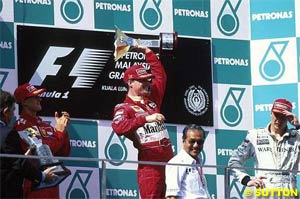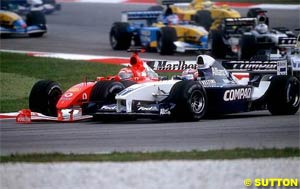
Atlas F1 Magazine Writer
Which driver has the most extraordinary record in Asian races? What do Mika Hakkinen and Juan Pablo Montoya have in common when it comes to Malaysia? And what happened this week in motor racing history? Marcel Schot brings the answers and more anecdotes on the second round of the season
The Japanese Grand Prix was first on the calendar in 1976, but after two races Asia was abandoned until 1987. Since then Japan has become a regular slot on the Formula One calendar. In 1994 and 1995 the country even had two races, when the Pacific Grand Prix was held at the TI Aida circuit. Since 1999, the number of Asian countries with a Grand Prix has increased to two, with the arrival of the Malaysian Grand Prix.
With the current qualifying rules, it's becoming increasingly more difficult to tell who's got a good chance of lining up near the front of the grid. This is clearly shown by the fact that after four consecutive pole positions in Malaysia, Michael Schumacher was last year beaten by the Renaults, who were arguably lower on fuel than the Ferraris. Whereas in previous years the qualifying results were more a measure of the car's strength, they don't say much now.
When looking at the times when the fastest race laps were driven by each driver last year in Malaysia, it shows that the Bridgestone tyres were less stable than the Michelins. Four of the Bridgestone drivers set their fastest laptime on the freshest possible rubber, in the second lap after a pitstop. Ralph Firman and Justin Wilson were the only drivers on Bridgestones who set their fastest lap considerably closer before a pitstop than after a pitstop.
If we look at Michelin, things are a lot more mixed between fresh tyres and low fuel. Three drivers set their fastest lap just before a pitstop or the end of the race, three just after a pitstop and two halfway through a stint. In the end results, 23 points went to Michelin and 14 to Bridgestone, with Bridgestone's top team Ferrari finishing second and sixth.
Two of a Kind
Before last year's all Renault front row, there had been only two non-Ferrari drivers on the front row in the history of the Malaysian Grand Prix. In 2000 Mika Hakkinen put his McLaren alongside Michael Schumacher, while Juan Pablo Montoya qualified second in the Williams in 2002. The comparison continues with both drivers being warped back because of penalties incured during the start.
While Hakkinen was slightly faster than Michael Schumacher in the first free practice session, the German reigned in qualifying. Mika Hakkinen, David Coulthard and Schumacher's teammate Rubens Barrichello all were close together nearly half a second behind. Hakkinen grabbed second place right at the end of the session, going three hundredths faster than Coulthard and Barrichello.
When the race was just about to get underway, Hakkinen's car moved slightly before the lights went out. The car came to a standstill again, but the false start was already recorded. Hakkinen got away clean and grabbed the lead, only to dropp back behind Coulthard, Schumacher and Barrichello after three laps in anticipation of his upcoming penalty. The Finn entered the pitlane for his 10 seconds 'stop and go', and came back out all the way at the back of the field.
Two years later, Juan Pablo Montoya was the one to put a dent in Ferrari's qualifying domination at Sepang. The Colombian was the only driver who could follow Michael Schumacher, as he posted a time two tenths slower than the German's. The second Ferrari of Rubens Barrichello was a distant third, six tenths behind, while Montoya's teammate Ralf Schumacher was the only other driver to stay within a second of the pole-sitter.
When the race got underway, Schumacher's Ferrari swerved to the right, blocking the passage for Montoya, who came around the outside of the Ferrari in the first corner. Both drivers collided, sending Schumacher into the pits with a damaged front wing and dropping Montoya all the way down to eleventh place. Just as the Williams driver was rapidly fighting his way back to the front, he was presented with a drive through penalty for having caused an avoidable collision. The Colombian served his penalty from sixth place, which threw him back to ninth.
Montoya fought his way up, first passing Allan McNish on lap 15 - just as David Coulthard made his pitstop - and then passing Mika Salo. Kimi Raikkonen's retirement helped Montoya move up into fifth place and after 27 laps Nick Heidfeld had to make way for the charging Williams driver. Just in time for the second round of pitstops, Rubens Barrichello retired ahead of Montoya, rewarding the Colombian's fighting spirit with a podium position.
After that, Montoya charging towards BAR driver Jenson Button, who was struggling hard to keep second place. 13 laps from the end the Briton had to give in and Montoya moved up into second place. This secured a one-two for Williams, as Montoya's teammate Ralf Schumacher was leading far ahead.
This Week in History
On March 22nd 1992 Michael Schumacher scored his first podium finish. After making his debut with Jordan at Spa during the previous season, Schumacher was quickly contracted by Benetton. He completed the season for Flavio Briatore's team and continued to drive for them in 1992. After the South African Grand Prix, in which Schumacher finished fourth, the second race of the season was in Mexico.
Practice started out well for the German. In free practice on Friday the Benetton driver managed a third position, ahead of both McLarens. More importantly, Schumacher was the only driver anywhere close to the Williams of Riccardo Patrese. Nigel Mansell was in a class of his own, but Schumacher managed to set a time just two tenths behind the second Williams driver, while Gerhard Berger was nearly eight tenths behind the Italian.
In the afternoon Schumacher was even faster than Patrese and managed a second position in the first official qualifying session. Unfortunately for the German, however, Patrese found a lot of speed overnight. In fact, the Williams driver almost managed to steal pole position away from Nigel Mansell. However, there was still a huge gap between Schumacher and the driver behind him. Next to the German was Martin Brundle, who was a staggering 1.3 seconds slower than his young teammate. Both McLarens made up the third row on the grid, with Berger slightly faster than Senna.
When the race got underway on Sunday, Schumacher wasn't able to keep his position. Ayrton Senna had the better start and darted past Schumacher, who blocked Berger. Martin Brundle, on the other side, got away cleanly and thus Schumacher was demoted to fifth before the first corner. On the next lap Schumacher was up a place again, as he was clearly faster than Brundle. The German immediately opened a two second gap to his teammate and put number three Ayrton Senna under pressure.
After eleven laps Senna retired with transmission problems, handing Schumacher third place and a clear path ahead. Riccard Patrese in second was six seconds ahead of the Benetton driver and clearly faster, while leader Nigel Mansell was almost ten seconds ahead of Schumacher. As the two Williamses were out of reach, Schumacher concentrated on his own race, increasing the gap to Brundle. The Briton behind him was fighting with Gerhard Berger, but managed to block the Austrian long enough to eliminate any threat for Schumacher.
Once Brundle's engine blew up after 47 laps, Berger finally had a clear road, but the gap remained around ten seconds and Schumacher never came under threat in the final twenty laps of the race, scoring his first podium finish, on his eighth Grand Prix.
After the opening round of the season in Australia, it's now time for the Formula One circus to head to Asia. And, with four races on that continent this year, it's worth investigating how the teams have done in Asia in the past.
 When looking at the winners in Asia, it's clear that the man who leads just about every statistical category is even more successful here. Michael Schumacher has won no less than nine races in Asia. The only other drivers to have won in Asia more than once are Gerhard Berger, Ayrton Senna, Damon Hill and Mika Hakkinen, who each won twice. The six time World Champion has won both Pacific Grands Prix, five Japanese Grands Prix as well as two Malaysian races. In qualifying the German was even more dominating. In eleven of his twenty races in Asia Schumacher started from pole position.
When looking at the winners in Asia, it's clear that the man who leads just about every statistical category is even more successful here. Michael Schumacher has won no less than nine races in Asia. The only other drivers to have won in Asia more than once are Gerhard Berger, Ayrton Senna, Damon Hill and Mika Hakkinen, who each won twice. The six time World Champion has won both Pacific Grands Prix, five Japanese Grands Prix as well as two Malaysian races. In qualifying the German was even more dominating. In eleven of his twenty races in Asia Schumacher started from pole position.
 Hakkinen got up to speed and quickly made his way past most of the field. By lap 21, the McLaren driver was back up in the top ten and a series of pitstops moved him up to fourth place. Hakkinen shortly dropped back to sixth when he made his only planned pitstop after 35 laps. Once Jacques Villeneuve and Eddie Irvine made their second stops, the Finn was solidly in fourth place, gaining almost one and a half seconds per lap on Villeneuve. However, Rubens Barrichello proved much too far head and Hakkinen had to settle with fourth place.
Hakkinen got up to speed and quickly made his way past most of the field. By lap 21, the McLaren driver was back up in the top ten and a series of pitstops moved him up to fourth place. Hakkinen shortly dropped back to sixth when he made his only planned pitstop after 35 laps. Once Jacques Villeneuve and Eddie Irvine made their second stops, the Finn was solidly in fourth place, gaining almost one and a half seconds per lap on Villeneuve. However, Rubens Barrichello proved much too far head and Hakkinen had to settle with fourth place.
|
Contact the Author Contact the Editor |
Please Contact Us for permission to republish this or any other material from Atlas F1.
|
Volume 10, Issue 11
Atlas F1 Exclusive
Inside View into WilliamsF1 with Gene
Interview with Giorgio Pantano
Articles
Every Other Sunday
The Paint Job: Part III
2004 Malaysian GP Preview
2004 Malaysian GP Preview
Malaysian GP Facts & Stats
The F1 Trivia Quiz
Columns
Rear View Mirror
On the Road
Elsewhere in Racing
The Weekly Grapevine
> Homepage |